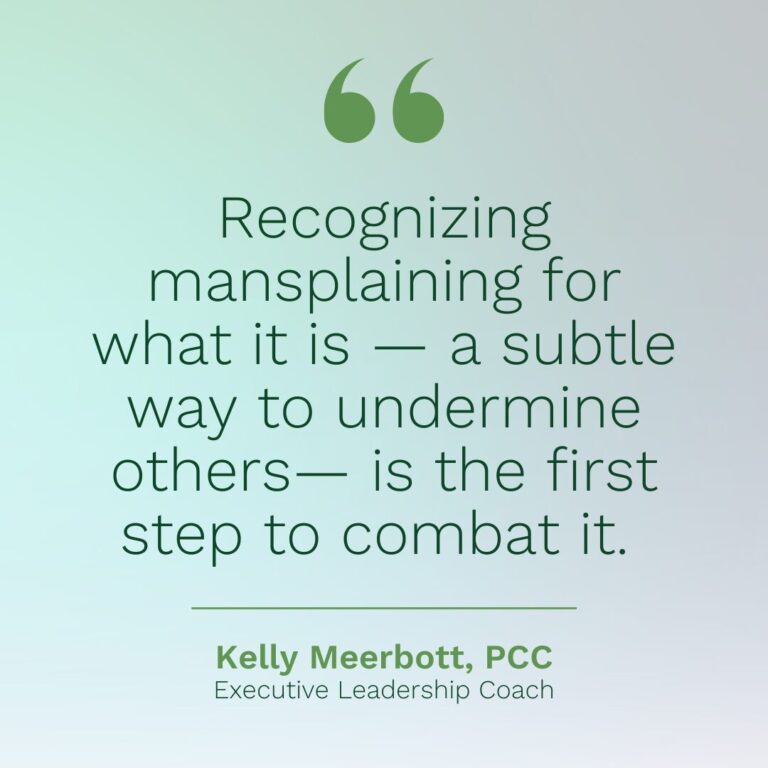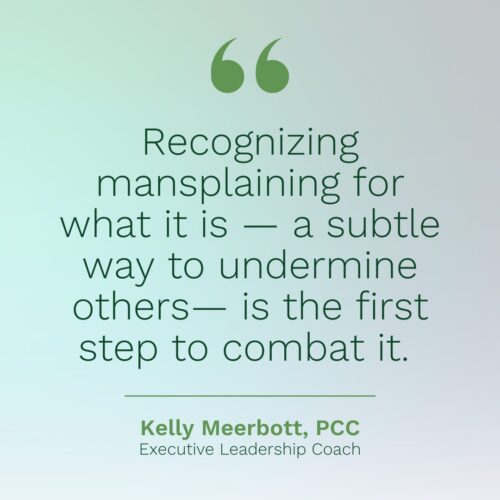Despite the push for diversity and inclusion, female leaders still face unique challenges that men often don’t. One of the most frustrating of these challenges is “mansplaining.” Mansplaining occurs when a man assumes a woman lacks understanding on a subject and condescendingly explains it to her, even if she’s an expert on the subject.
As an executive coach with over 15 years of experience and more than 10,000 coaching hours, I’ve seen how mansplaining can erode confidence and stifle voices. But with the right approach, female leaders can turn this challenge into an opportunity to assert their authority and ensure their voices are heard and respected.
Understanding Mansplaining
Mansplaining isn’t just a harmless interruption; it’s a manifestation of deep-rooted biases and power dynamics that have been ingrained in our society for centuries. When a man mansplains, he’s reinforcing a narrative that undermines women’s authority and expertise.
It’s important to understand that mansplaining is not just about the words spoken; it’s about the underlying assumption that a woman’s knowledge or experience is less valid. This can create an environment where women feel the need to constantly prove themselves, rather than focusing on contributing their expertise. To counter this, it’s essential to not only address the specific instances of mansplaining but also to challenge the broader attitudes that allow it to thrive.

Strategies to Handle Mansplaining
1. Assert Your Expertise
When mansplaining occurs, don’t shrink back. Assert your expertise immediately. A simple, confident statement like, “I’m aware of that. I’ve successfully implemented similar strategies before,” can shift the room’s energy and solidify your authority. By doing this, you’re not only stopping the mansplaining in its tracks but also reinforcing your position as a knowledgeable leader.
Remember, your expertise is your strength. You’ve worked hard to develop it, so don’t hesitate to showcase it. When you assert your knowledge confidently, you not only command respect but also set a precedent for how you expect to be treated in the workplace.
2. Use Strategic Interruptions
Interruptions can be powerful tools when used correctly. If someone starts mansplaining, cut in with, “Let me stop you there—I have a different perspective based on my experience with [specific example].” This not only redirects the conversation back to your expertise but also demonstrates that you are in control of the discussion.
Mastering the art of interruption is about timing and delivery. It’s not about being rude or confrontational but about asserting your right to speak and be heard. Practice this skill in less formal settings until you feel confident enough to use it in more high-stakes situations.
3. Reclaim the Conversation
Mansplaining often derails conversations, taking them in directions that are irrelevant or unproductive. Don’t let the conversation spiral out of your control. Reclaim it with statements like, “That’s an interesting point, but I’d like to focus on how this impacts our current project.” By steering the discussion, you maintain authority and ensure the conversation serves your leadership and the organization’s goals.
Reclaiming the conversation is about more than just redirecting; it’s about ensuring that your voice is central to the dialogue. When you guide the conversation, you reinforce your role as a leader and decision-maker.
4. Address the Behavior Directly
Sometimes, the only way to deal with mansplaining is to call it out directly. Address it calmly but firmly: “I’ve noticed you often repeat points I’ve already made. I’m confident in my understanding, and I’d appreciate it if we could build on what’s been said.” This sets a clear boundary and demands respect.
Addressing mansplaining head-on can be uncomfortable, but it’s necessary. By bringing attention to the behavior, you not only stop it in the moment but also signal to others that such behavior will not be tolerated. This can have a ripple effect, encouraging others to be more mindful of their interactions.
5. Leverage Allies
Building a network of allies, especially male colleagues, can be a game-changer in combating mansplaining. When someone begins to talk over you, an ally can redirect the focus: “Actually, I think [Your Name] was about to make a point. Let’s hear her thoughts on this.” This not only amplifies your voice but also signals that your contributions are valued by others.
Allies can be powerful advocates for your voice, especially in male-dominated environments. Don’t hesitate to discuss the issue with trusted colleagues and ask for their support in meetings. When you have allies who back you up, it strengthens your position and discourages others from undermining you.
6. Maintain Composure and Professionalism
When faced with mansplaining, it’s natural to feel frustrated or angry. However, maintaining your composure is key to handling the situation effectively. A calm, steady response like, “Thank you, but let’s stay focused on the main point,” demonstrates control and reinforces your authority without escalating the situation.
Staying composed also sets a tone of professionalism that others are likely to follow. It shows that you are confident in your abilities and that you won’t be rattled by condescending behavior. This not only helps in the moment but also builds your reputation as a leader who can handle difficult situations with grace.
7. Develop a Strong Personal Brand
Your personal brand is your most powerful tool against mansplaining. By consistently demonstrating your expertise, speaking up in meetings, publishing thought leadership, and taking the lead in key projects, you establish a brand that’s hard to undermine. A strong personal brand acts as a barrier against mansplaining because it makes it clear that you are a force to be reckoned with.
Your brand is your professional identity—cultivate it carefully. The stronger your brand, the harder it becomes for anyone to question your authority or expertise. Make sure your brand reflects your values, your strengths, and your vision for leadership.
8. Seek Feedback and Reflect
After facing mansplaining, seek feedback from trusted colleagues or mentors. Ask for honest input on how you handled the situation and where you can improve. Continuous reflection and adjustment will only strengthen your approach in future encounters.
Feedback is essential for growth. Use it to fine-tune your strategies and to ensure that you’re always improving in how you handle difficult situations. Reflection allows you to learn from each experience and to develop even more effective ways to assert your authority.
9. Educate and Advocate
Don’t just combat mansplaining on a personal level—work to eradicate it within your organization. Advocate for cultural change by promoting discussions on unconscious bias, pushing for gender equality training, and supporting initiatives that empower women in leadership. By educating others and advocating for change, you’re not just protecting yourself—you’re paving the way for future generations of female leaders.
Advocacy is about creating a better environment for everyone. When you take the lead in promoting equality and challenging biases, you help to create a culture where mansplaining and other forms of discrimination are less likely to occur. Your efforts can lead to lasting change, making your workplace more inclusive and respectful for all.
10. Share and Reclaim Your Ideas
To ensure your ideas are credited to you:
- Document and Share: After meetings, send follow-up emails that clearly outline your ideas. This creates a record of your contributions.
- Public Acknowledgment: When presenting, make it clear that the idea originated with you.
- Reclaim and Reinforce: If someone tries to take credit for your idea, assertively clarify that it was yours and expand on it.
Documenting and sharing your ideas is crucial for ensuring that you get the recognition you deserve. By being proactive about claiming ownership of your contributions, you can prevent others from taking credit for your work.
Yes, You Can Stop Mansplaining
Mansplaining is a subtle yet pervasive challenge that many female leaders encounter. But with the right strategies, you can not only counteract it but also redefine the dynamics of your workplace.
By asserting your expertise, strategically interrupting, reclaiming conversations, addressing the behavior directly, leveraging allies, maintaining composure, developing a strong personal brand, seeking feedback, and advocating for change, you don’t just combat mansplaining—you crush it.
Your voice is powerful—use it to command respect and confidently lead.






